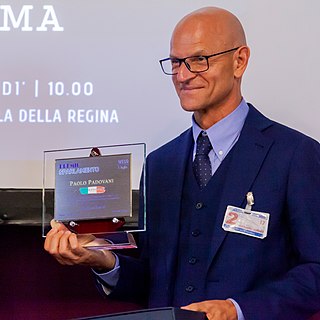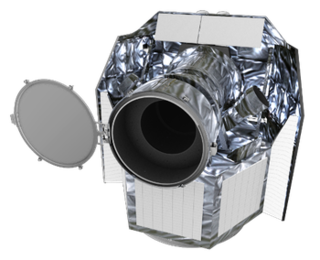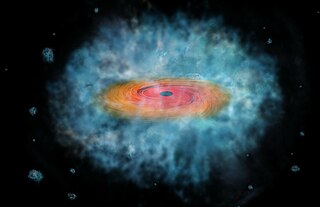Related Research Articles

A quasar is an extremely luminous active galactic nucleus (AGN). It is sometimes known as a quasi-stellar object, abbreviated QSO. The emission from an AGN is powered by a supermassive black hole with a mass ranging from millions to tens of billions of solar masses, surrounded by a gaseous accretion disc. Gas in the disc falling towards the black hole heats up because of friction and releases energy in the form of electromagnetic radiation. The radiant energy of quasars is enormous; the most powerful quasars have luminosities thousands of times greater than that of a galaxy such as the Milky Way. Quasars are usually categorized as a subclass of the more general category of AGN. The redshifts of quasars are of cosmological origin.

Halton Christian "Chip" Arp was an American astronomer. He was known for his 1966 Atlas of Peculiar Galaxies, which catalogues many examples of interacting and merging galaxies, though Arp disputed the idea, claiming apparent associations were prime examples of ejections. Arp published Seeing Red: Redshift, Cosmology and Academic Science in 1998. Arp was also known as a critic of the Big Bang theory and for advocating a non-standard cosmology incorporating intrinsic redshift.

Gaia is a space observatory of the European Space Agency (ESA), launched in 2013 and expected to operate until 2025. The spacecraft is designed for astrometry: measuring the positions, distances and motions of stars with unprecedented precision, and the positions of exoplanets by measuring attributes about the stars they orbit such as their apparent magnitude and color. The mission aims to construct by far the largest and most precise 3D space catalog ever made, totalling approximately 1 billion astronomical objects, mainly stars, but also planets, comets, asteroids and quasars, among others.
Redshift quantization, also referred to as redshift periodicity, redshift discretization, preferred redshifts and redshift-magnitude bands, is the hypothesis that the redshifts of cosmologically distant objects tend to cluster around multiples of some particular value.
(Geoffrey) Michael Rowan-Robinson is an astronomer, astrophysicist and Professor of Astrophysics at Imperial College London. He previously served as head of the astrophysics group until May 2007 and from 1981 to 1982, and as Gresham Professor of Astronomy.

Paolo Padovani is an Italian astronomer working at the European Southern Observatory, specializing in the study of Active galactic nuclei including the study of quasars and blazars, evolution and multifrequency studies and extragalactic backgrounds. In 2004 he and several other astronomers discovered 30 supermassive blackholes at the European Astrophysical Virtual Observatory using pioneering techniques.
Luminous infrared galaxies or LIRGs are galaxies with luminosities, the measurement of brightness, above 1011 L☉. They are also referred to as submillimeter galaxies (SMGs) through their normal method of detection. LIRGs are more abundant than starburst galaxies, Seyfert galaxies and quasi-stellar objects at comparable luminosity. Infrared galaxies emit more energy in the infrared than at all other wavelengths combined. A LIRG's luminosity is 100 billion times that of the Sun.

Transiting Exoplanet Survey Satellite is a space telescope for NASA's Explorer program, designed to search for exoplanets using the transit method in an area 400 times larger than that covered by the Kepler mission. It was launched on 18 April 2018, atop a Falcon 9 launch vehicle and was placed into a highly elliptical 13.70-day orbit around the Earth. The first light image from TESS was taken on 7 August 2018, and released publicly on 17 September 2018.

In cosmology, the steady-state model or steady state theory is an alternative to the Big Bang theory of evolution of the universe. In the steady-state model, the density of matter in the expanding universe remains unchanged due to a continuous creation of matter, thus adhering to the perfect cosmological principle, a principle that says that the observable universe is always the same at any time and any place.
The Nano-Japan Astrometry Satellite Mission for Infrared Exploration (Nano-JASMINE) is an astrometric microsatellite developed by the National Astronomical Observatory of Japan, with contributions by the University of Tokyo's Intelligent Space Systems Laboratory (ISSL). As of 2015, the satellite was planned for launch together with CHEOPS in 2019. However, this launch took place in December 2019 without Nano-JASMINE as one of the three piggyback payloads. Some sources named 2022 as the launch year of the satellite.

CHEOPS is a European space telescope. Its objective is to determine the size of known extrasolar planets, which will allow the estimation of their mass, density, composition and their formation. Launched on 18 December 2019, it is the first Small-class mission in ESA's Cosmic Vision science programme.
Stephen Eales is a professor of astrophysics at Cardiff University, where he is currently head of the Astronomy Group. In 2015, he was awarded the Herschel Medal from the Royal Astronomical Society for outstanding contributions to observational astrophysics. He also writes articles and books about astronomy.

Carole Ann Haswell is a British astrophysicist and current Professor of Astrophysics and Head of Astronomy at the Open University. She is a Fellow of the Royal Astronomical Society. She has been involved in the detection of several exoplanets, including Barnard's Star b.

Direct collapse black holes are high-mass black hole seeds, putatively formed within the redshift range , when the Universe was about 100–250 million years old. Unlike seeds formed from the first population of stars (also known as Population III stars), direct collapse black hole seeds are formed by a direct, general relativistic instability. They are very massive, with a typical mass at formation of ~105 M☉. This category of black hole seeds was originally proposed theoretically to alleviate the challenge in building supermassive black holes already at redshift , as numerous observations to date have confirmed.

Rosemary Theresa Coogan is an astrophysicist from Northern Ireland. Her research considers galaxy evolution and space-based telescopes. She was selected as a member of the 2022 European Space Agency Astronaut Group.
References
- 1 2 3 "Meet Dr Kate Isaak". www.space-awareness.org. Retrieved 30 December 2019.
- ↑ EU Space Awareness Career Interviews: Kate Isaak, Project Scientist // 02 Early experience , retrieved 30 December 2019
- ↑ "Dr W Owen Saxton". Murray Edwards College - University of Cambridge. 27 July 2015. Retrieved 30 December 2019.
- ↑ Isaak, K. G.; McMahon, R. G.; Hills, R. E.; Withington, S. (July 1994). "Observations of high-redshift objects at submillimetre wavelengths". MNRAS. 269: L28–L32. Bibcode:1994MNRAS.269L..28I. doi: 10.1093/mnras/269.1.L28 . ISSN 0035-8711.
- ↑ "Spaceflight Now | Breaking News | Astronomers detect stellar ashes at the dawn of time". spaceflightnow.com. Retrieved 30 December 2019.
- ↑ Cox, P.; Omont, A.; Djorgovski, S. G.; Bertoldi, F.; Pety, J.; Carilli, C. L.; Isaak, K. G.; Beelen, A.; McMahon, R. G.; Castro, S. (May 2002). "CO and Dust in PSS 2322+1944 at a redshift of 4.12". Astronomy & Astrophysics. 387 (2): 406–411. arXiv: astro-ph/0203355 . Bibcode:2002A&A...387..406C. doi: 10.1051/0004-6361:20020382 . ISSN 0004-6361.
- ↑ Raymond, Gwenifer; Isaak, Kate G.; Clements, Dave; Rykala, Adam; Pearson, Chris (25 June 2010). "The Effectiveness of Mid IR / Far IR Blind, Wide Area, Spectral Surveys in Breaking the Confusion Limit". Publications of the Astronomical Society of Japan. 62 (3): 697–708. arXiv: 1003.5541 . Bibcode:2010PASJ...62..697R. doi: 10.1093/pasj/62.3.697 . ISSN 0004-6264.
- ↑ Swinyard, Bruce; Nakagawa, Takao; Matsuhara, Hideo; Griffin, Doug; Ferlet, Marc; Eccleston, Paul; di Giorgio, Anna; Baselmans, Jochem; Goicoechea, Javier; Isaak, Kate; Mauskopf, Phillip (12 July 2008). Oschmann, Jr, Jacobus M; De Graauw, Mattheus W. M; MacEwen, Howard A (eds.). "The European contribution to the SPICA mission". Space Telescopes and Instrumentation 2008: Optical, Infrared, and Millimeter. SPIE. 7010: 70100I. Bibcode:2008SPIE.7010E..0IS. doi:10.1117/12.789195. S2CID 122283902.
- ↑ "November 12, 2009". In the Dark. Retrieved 30 December 2019.
- ↑ "Kate Isaak, ESA CHEOPS Project Scientist". www.esa.int. Retrieved 30 December 2019.
- ↑ "Kate Isaak". spie.org. Retrieved 30 December 2019.
- ↑ "European Space Agency launches CHEOPS exoplanet mission". Physics World. 18 December 2019. Retrieved 30 December 2019.
- ↑ Isaak, K. G.; Benz, W. (September 2019). "The next exoplanet mission to fly". Nature Astronomy. 3 (9): 873. Bibcode:2019NatAs...3..873I. doi: 10.1038/s41550-019-0886-9 . ISSN 2397-3366.
- ↑ "European space telescope to measure distant worlds". BBC News. Retrieved 30 December 2019.
- ↑ "Kate Isaak - Personal Profiles - Cosmos". www.cosmos.esa.int. Retrieved 30 December 2019.
- ↑ "Call for Media: Cheops launch to study exoplanets". www.esa.int. Retrieved 13 December 2019.
- ↑ "Team". LIFE space mission. Retrieved 30 December 2019.